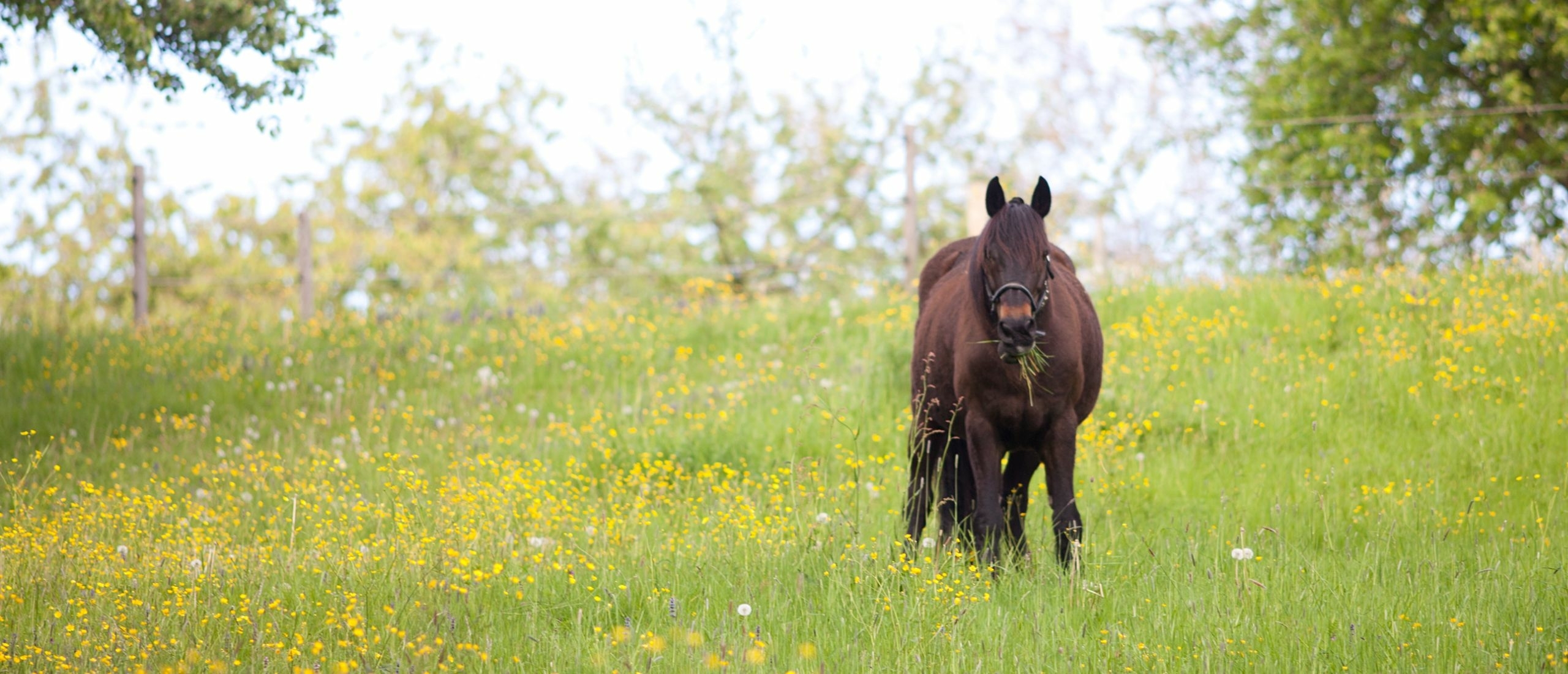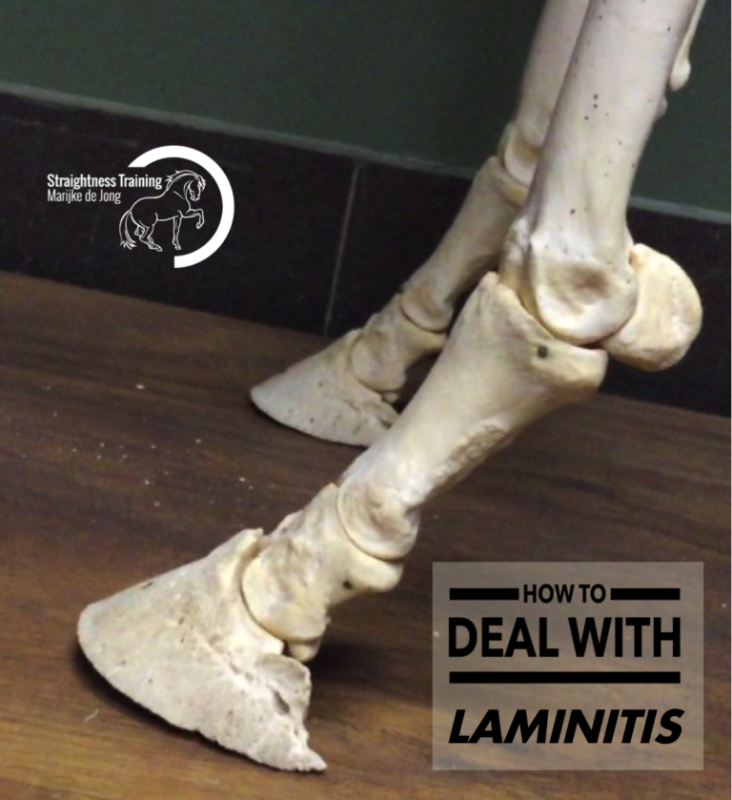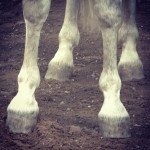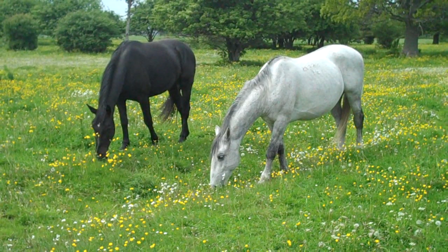- Risks and causes of laminitis
- How to prevent laminitis
- How to treat acute laminitis
- 12 Guidelines for going back to work
- #1: As soon as the horse is not very much in pain, you can go on short walks with him to improve the blood circulation. On these short walks avoid sharp turns to not stress the healing hoof.

How to deal with laminitis
 Laminitis is a common cause of lameness. It is a painful inflammatory condition of the tissues, called ‘laminae’, that bond the hoof wall to the coffin bone in the horse’s hoof.
Laminitis is a common cause of lameness. It is a painful inflammatory condition of the tissues, called ‘laminae’, that bond the hoof wall to the coffin bone in the horse’s hoof.
Subclinical laminitis is the early stage of laminitis where structural changes have occurred within the hoof, without the horse being obviously lame or short in the stride or having sore feet in the front feet.
Acute laminitis occurs when they symptoms are very sudden and the horse is severly crippled and in pain; he’s cripple, he puts his front feet in front of him and he puts his hind legs under his body to avoid lighten the front feet. It’s important to treat acute laminitis immediately by a vet within 1 or 2 days, to ensure that it doesn’t become chronic.
Chronic laminitis means that the coffin bone is detached from the hoof wall. If acute laminitis is not treated promptly, the coffin bone drops or rotates downwards, pressuring the sole. Compare it with a person who has a loose fingernail.
Risks and causes of laminitis
 Laminitis is traditionally considered a very crippling disease of fat horses, but it can be triggered by a variety and combination of causes in any horse:
Laminitis is traditionally considered a very crippling disease of fat horses, but it can be triggered by a variety and combination of causes in any horse:
- Excessive intake of grass
- Excessive intake of grain
- Overweight
- Lack of movement
- High insulin levels
- Metabolic issues (EMS, PPID)
- Medication with corticosteroids
How to prevent laminitis
Prevention is better than cure, so here are some tips to minimize the risks:
1. Control your horse’s weight
- An overweight horse has a higher risk of laminitis. So check if your horse has ideal weight: You should be able to feel your horse’s ribs, but not see them. And the neck should not be thick and a horse should have no crest on the neck.
- Exercise an overweight horse is the most effective way to control body weight. Straightness Training will help you with that.
- Avoid too long time being locked up in a stall. Turn out in paddocks for more exercise each day.

2. Manage grazing carefully
- Feed mature grass. When the grass is longer and stalky the energy values drop. s.
- Restrict the horse’s intake of fresh grass to avoid high levels of sugar.
- Avoid grazing on fresh grass in the morning when the mornings are warm and sunny and the nights are cold (below 5 degrees Celsius). Warm clear days and cool nights provide the perfect conditions for build up of sugars (fructan). Fresh grass is safest at night or later in the evening, when fructan levels are in decline.
- Let the horse graze for only a limited amount of time.
- Strip grazing is a good and safe alternative, because the horse has only access to a limited amount of grass.
- Another alternative is a sand arena with hay (in nets). Feed hay made from mature flowering grasse and spread it so the horse has to move more.
3. Manage food carefully
- When feeding concentrates, feed little and often, rather than two times a day a large portion.
- Avoid high levels of grain, cereals and mueslis, to avoid high levels of carbohydrates.
- Avoid melasse.
4. Proper hoofcare
- Regular trimming and correct foot balance are essential for healthy feet.
5. Proper housing
- Movement is key for healthy hoofs, so make sure a horse doesn’t only move in training.
- Avoid 23 hours in the stall.
- Turn out in paddocks for more movement each day.
How to treat acute laminitis
A horse that has access to unlimited fresh grass or grain might eat an enourmous amount of sugar and this can lead to acute laminites. If you have just discovered a horse with laminitis, than here are some tips on how to deal with this:
- Make sure this horse can’t eat any more sugar or carbohydrates. The horse should be completely removed from grass (sugar), and don’t give him any grains (carbohydrates that will be broken down to sugars), and don’t give him any food that contains sugar, such as apples, carrots, vanilla goodies etc.
- If you need to remove him from the grass, move your horse as little as possible and support his feet with wet bandages to reduce the pain. If needed use a trailer with supportive bedding to move him from the field to the stable,
- Call the vet to determine the cause. To reduce inflammation and pain the vet may describe a nonsteroidal anti-afflammatory medicin (such as bute, danilon, etc.) to reduce the pain and to inhibit inflammation and to avoid the rotation or the dropping of the coffin bone. These medications should not be used for more than 3 – 5 days.
- Call the farrier because correct foot balance and allignment and support are very important to reduce the pain and pressure. That doesn’t mean that you need nailed shoes on your horse – on the contrary, shoeing reduces blood circulation and hinders recovery, therefore be even more harmful – but proper trimming is very important.
- While waiting for the vet use some ice packs or put your horse in a cold running water stream. Cold is the best way to control inflammation and give pain relief.
- Create a deep supportive bedding such as (moist) sand or sawdust.
If the pain is not obviously reduced within 3 to 7 days, you have not eliminated or treated the cause of the laminitis or you have not correctly supported or realigned the feet. Remember: you cannot get the pain in the hoofs under control unless you remove the cause of the laminitis. So take care to not only focus on reducing and controlling the pain with medicins, mainly focus on the healing of the hooves.
If the pain is obviously reduced, because your emoved the cause and adequately supported the feet, the healing will begin. Then no special medicins are needed, since the horse’s own body has a huge healing capacity. Let Mother Nature do her job, because the more interferance with drugs, medicins and treatments, the more difficult it is for the horse to heal itself. Therefore:
- No special shoes are required. Just keep the hoofs in balance and aligned and shape them so they support the horse best in the healing process. Well trimmed feet can’t 100% prevent rotation or sinking of the coffin bone but poor quality hooves greatly increase the chances. Have an X-ray made so you can check the amount of rotation and sinking of the coffin bone.
- Avoid any long term use of anti-inflammatory medications or antibiotics in the hope to avoid future inflammations or absesses. Because when used on a consistent basis some of these medicins has been found to decrease bone and soft tissue healing, and may increase the risk of soft tissue infection. Medicins might overstrain the liver and antibiotics kill healthy bacteria in the gutt, and these bacteria are necessary for a healthy metabolism. Let Mother Nature do her job and let the horse heal itself.
- Movement is key for healthy hoofs, so make sure the horse has the opportunity to move, since it promotes the hoofmechanise.The hoof mechanism ensures better circulation and blood flow is needed to remove waste and to provide new nutrients. It’s counterproductive to keep a horse 24/7 in a stall, it will disturb the hoof mechanism and toxins accumulate in the hoof.
- Provide good soil. A soft soil is pleasant for the hooves but hardly any hoof mechanism (resulting in little or no blood circulation) can take place in a very soft soil. Rubber mats or a medium hard sandy soil without gravel and stones is most ideal for horses with sore hooves.
- Take the time it takes to heal. It might take a long time for the horse to move without sensitivity on gravel paths. As long as the laminae are weak and the sole is irritated, also walking on hard roads, frozen ground and stones might cause pain.
12 Guidelines for going back to work
#1: As soon as the horse is not very much in pain, you can go on short walks with him to improve the blood circulation. On these short walks avoid sharp turns to not stress the healing hoof.
- #2: When the horse has no pain and the bond between the hoof wall and the coffin bone has healed, you can start training again.
- #3: Team up with your veterinarian to determine the best exercise program for your horse.
- #4: Work on a medium hard sandy soil.
- #5: Start with Groundwork in walk and ‘observe first, produce later‘;
- #6: First determine any imbalance and stiffness in the body arised because the body started compensating with other parts of the body to lighten the painful hoofs.
- #7: Help the horse to stretch the stiff and shortened muscles and rebalance the possible shifted center of mass. So mainly focus on the first 3 keys of Straightness Training , the LFS, to develop a proper lateral bend in the body to both sides (L), to create a consistent forward down tendency and ‘dropping’ of head and neck (F), and to have the inside hind leg stepping under and supporting the correct positioned center of mass (S).
- #8: Only when the horse has a correct and consistent LFS start to strengthen the hind legs and build muscles with keys #4, #5 and #6. Start developing these keys in Work in hand in walk.
- #9: In Longeing you can improve the LFS in trot. Take care not to make the circles too small.
- #10: When your horse is doing fine in Work in hand and Longeing, you can start Riding again.
- #11: Use ST for the horse, not the other way around. Use the training pillars and the exercises in a way that serves the horse best. So use ST to help the horse to rebalance, to get him fit and supple again and to have him move in relaxed activity.
- #12: Avoid any stress. When a horse is stressed, the horse’s body responds by releasing corticosteroids and this influences the blood levels. And these alterations in the blood flow to the feet can then lead to a laminitic episode.

